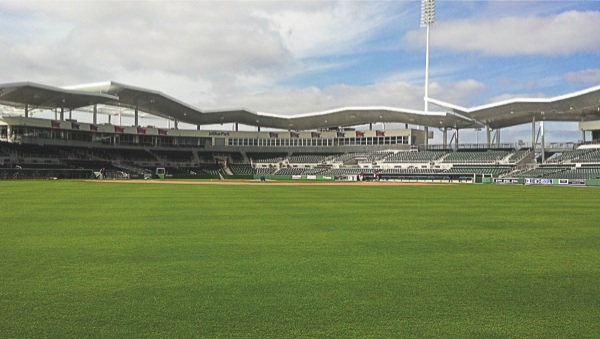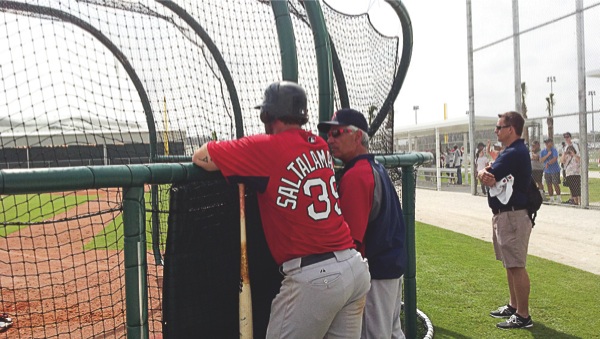Sam Geati, N-33, is a snow bird who spent part of the winter in Ft. Myers, FL. Here is his report on the Minnesota Twins and Boston Red Sox camps, along with reflections on days past as a young boy who dreamed of being a major leaguer some day.
It’s mid-February in Ft. Myers, FL, and only the pitchers and catchers have arrived for Spring Training. The rest of the players will show up later this month. It is very open and loose at the camps, so I can get pretty close to the players, who consist of a combination of current team members and this year’s hopefuls, plus a large number of Double A and Triple A minor leaguers.
Last year, I had the pleasure of meeting the Twins’ Joe Mauer, the team’s most outstanding player and previous league MVP. Joe wears #7, stands 6’5”, and weighs about 230 pounds. Standing anywhere near this guy is so embarrassing for me, since I’m barely 5’6”. But Joe is so laid back and anything but standoffish. He was born in St. Paul, MN on April 19, 1983. He fits his team perfectly, being a hometown boy. Even though his Twins regularly beat my favorite team, the White Sox, I can’t help but be in awe and admire him because he is a future Baseball Hall of Famer with a down-to-earth demeanor and attitude. He’s not typical of a good number of today’s players, many of whom are arrogant, avoid all contact with the fans, and want money for autographs. Mauer is every fan’s dream player; the guy you want on your team.

JetBlue Park. (All photos by Sam Geati)
My first introduction to Joe occurred, of all places, in his Ft. Myers garage. My brother-in-law introduced me to him last winter. He told me that Joe lived just a couple of houses down on the same street. He said, “Come on, I’ll introduce you to him.” Yeah, right! When we walked into the open garage, there was Joe, building a workbench. I stood there thinking, “This guy could pick up the phone and get the best workbench money can buy delivered to his home the same day.” Not Joe; he’s got to use his tools and make his own. After shaking his hand, I just stood there, looking up and up, thinking, “This must be Paul Bunyan in real life!”

Che-Hsuan Lin with instructors.
Joe began his career as a catcher and now plays many games at first base, a deliberate move to help extend his playing years. He was selected as the first pick by the Twins in the 2001 draft. Since then, he has played in over 900 games and has a .323 career batting average. Last year was a tough year for Joe due to multiple injuries that reduced his playing time to only 82 of the 160-game schedule.
The big question in the Twins camp and around the league is: can Joe and his teammate, Justin Morneau (concussion), come back from an injury-riddled season? They are critical components in the Twins lineup. Without their successful return, the Twins will probably miss the playoffs again. You might think that being a Sox fan I would not be sympathetic to the Twins plight. But something happened when I met Joe. I couldn’t help but wish him the best in health. Don’t get me wrong, I want my team to beat his very badly and go all the way to the World Series again. However, beating the Twins without a healthy Joe and Justin would be a hollow victory.
This emotional attachment to the game of baseball and those that play the game is something that’s been with me for over 60 years. I clearly remember seeing my first major league game. It was a typical hot Chicago night with the Boston Red Sox in town to play my White Sox. My dad was a Sox fan, and I sensed his pride in being able to take his only son to Comiskey Park. As we approached the entrance to the stadium built, I was gawking all the way into the building. As I came through that gangway, the whole world changed in an instant. I stood there, looking out at the beautifully lit and groomed field, surrounded by 40,000 fans that came to see more than a game between these two teams. They were there to see the “Splendid Splinter,” Ted Williams, future Hall of Famer and surely one of the best hitters in baseball history. Finally, after a few innings, it happened. Williams gave the fans what they and I hoped to see: a Ted Williams home run! This night would forever be a treasured memory.
Thus, you see why the fascination with the Joe Mauers of baseball. These guys take people like me back to a different time, a simpler time, when I spent many hours with my ear glued to a transistor radio listening to every pitch of every inning described by the late Bob Elson, then-Sox announcer.
Occasionally, it’s a good thing to re-capture those times of our youth when there wasn’t anything more important than baseball. So, as I watch today’s players get ready for a new season, I feel sorry for them in one respect: they missed out on experiencing what it was like when baseball was a kid’s game.
On the next day, I got to interview the Twins bench coach, Scott Ullger. Scott is a former Major Leaguer who, since his playing days, has managed minor league teams and even stepped in for Twins Manager Ron Gardenhire for a few games in an emergency. In 1995, Ullger became the Twins’ first base coach. Later, he became the third base coach, a position which he held through the 2010 season. He has been the bench coach since that time. This allows him to work more closely with Manager Gardenhire. Scott, like Joe Mauer, was very accessible and graciously answered my questions about the young guys attempting to make an impression with the big league club. The Twins organization, he said, primarily believes in cultivating “home grown” talent, rather than spending large amounts of money on free agents, as is common with other teams. They invest a great deal of time and money in these youngsters, betting on the future with them. This is one of the reasons Scott believes the Twins organization has been so successful for so many seasons. Except for last year’s injury-riddled team, the recent record amassed by the Twins teams proves this to be true. However, the Twins did make an exception in 2010, when they signed a professional player from Japan.
Walking around the camp, I get to see the faces of the teenagers and other young men in camp. They appear so young, so nervous, and so anxious to make an impression. Reality has not set in for them yet. They are there with stars in their eyes, running around like rabbits chasing or charging balls hit near them, trying to hit every ball out of the park. They stand in awe of the guys who played on the team last year. They are hanging on to every word uttered by the coaching staff, coming from former Twin greats like Rod Carew and Tony Oliva. This is what intrigues me most as I walk the complex each day. It’s the kids! I can’t help but admire their enthusiasm, level of talent, and the obvious desire to someday make it to “the bigs.”
The next day, I moved on to Jet Blue Park, the beautiful new home of the Boston Red Sox.
JetBlue Park is a big part of the camp experience, as it is just opening this spring. The park, which will accommodate 11,000 fans, includes a near replica of the Green Monster in Boston’s Fenway Park and six practice fields on site.
My objective here is to look at players from different eras, including one from my generation, a major league rostered player, and a minor leaguer who was invited to the camp. At the entrance, I notice a statue of Hall of Famer Ted Williams, thought to be the greatest hitter of all time.

JetBlue Park's Green Monster.
Of course, it jolts me back to that first night game memory, and I relive it again. I stand there staring at the statue for a few minutes and soak it up. This is what baseball is to me: memories of watching these icons. One of the books I read a few years ago, “The Teammates: A Portrait of Friendship” by David Halberstam, is the story of Ted’s years as told by three of his teammates: Bobby Doerr, Johnny Pesky, and Dominic DiMaggio. I highly recommend it. Ted played his entire career with the Red Sox, a rarity among today’s players. He was a very studious hitter in that he would seek out other players to discuss hitting and argue with them about which techniques produced the best results. Most baseball fans know that before he died, Ted requested that he be cryogenically frozen at death. If he were alive, I could just imagine how he would be stunned by the hitters of today. Ted’s swing was a swing of beauty and grace, yet powerful in its day, whereas today’s hitters display swings that are more compact, faster, and definitely more powerful because of the emphasis on leg and arm strength.
One of the rostered players on the Red Sox is Jarrod Saltalamacchia, who holds the distinction of having the longest surname in the majors. Salty, as he is known by his teammates and coaches, was drafted out of high school in 2003 in the first round by the Atlanta Braves. In 2006, he had a breakout season and then after a series of trades over the next four years, he eventually ended up in the Red Sox organization as a minor league switch-hitting catcher.

Salty and Bobby Valentine.
In the 2011 season, Saltalamacchia was slated at the beginning of the year to be Boston’s starting catcher. Out of the gate, he struggled defensively and showed weakness in the batter’s box. However, he showed improvement at the plate as the season progressed, hitting .327 in the month of June. On January 15, 2012, Saltalamacchia avoided arbitration by signing a one-year, non-guaranteed contract worth $2.5 million. He is married and has three young girls. He is typical of the players who experience movement from team to team, which is really tough on family life, as is the long season traveling from city to city. However, he has a very good chance of solidifying his position as the starting catcher on the team. I can’t help but pull for him after getting an opportunity to get to know him as a family man who plays baseball for a living.
Later that day, I spent some time observing the minor league pitchers who are in camp, each hoping to make it back to Boston on the 40-man roster. Will Inman in one such invitee.
Inman’s not a kid anymore, like the AA players, having played seven years in the minors. He was originally a San Diego Padres pitching prospect who jumped onto pretty much everyone’s radar in 2006, when he tore it up in his first full season of Class A ball. He signed out of high school and was an immediate attention getter, limiting batters to a .182 average while amassing an impressive number of strikeouts.

Hammond Stadium.
Will’s throwing motion reminds me of the young pitcher in the movie “Bull Durham” who didn’t look at the plate until the last second. Will talked about the traveling aspect of life in the minors, which often calls for 12-hour bus trips leaving at midnight, getting in at noon, and playing at 7 p.m. This, for him, tends to lead to a very relaxed, easy-come, easy-go type of lifestyle. Will’s days consist of playing or practicing, eating, working out at the gym, or playing Halo, videogame. Inside him, though, is the burning desire to finally be a major leaguer. Typical of today’s younger players, Will’s iPhone is always nearby. Around these guys, I feel even older, just as I do when with my teenage grandkids.
The Red Sox also have an Asian-born prospect in camp. He is Che-Hsuan Lin (Chay shoo-ahn Lin), a native of Taiwan. Lin is a 23-year-old outfielder hoping to stay up in the majors this year.
Lin has played with Taiwan national teams, including the Junior World Championship squad in 2007. The Red Sox acquired Lin as an international free agent in June 2007. He has put up solid numbers since joining U.S. professional baseball the same year and was rated as having the best outfield arm in the Boston minor league system according to Baseball America. In 2010, Lin was chosen as the best defensive outfielder in Red Sox “Top 10 Prospect Scouting Report.” In 2008, Lin was selected for the annual All-Star Futures Game. He hit a two-run home run on the first pitch that gave the World team the victory over the U.S., 3–0. He finished 2-for-2 and was named the game’s Most Valuable Player.
He is now ranked eighth in the Red Sox prospects’ list. He also was selected to play in the Olympics for the Chinese Taipei team. This is his third year of being invited to spring training with the Red Sox. Lin seems to have acclimated to life in the U.S. I noticed that some of the other players kid around with him, some even saying things to him in Chinese, probably words and phrases he taught them. He hopes to stay with a big league team this year, after spending the past year in Triple-A. In addition to the challenge of making the majors, he has to learn English and compete with players from around the world.
Some players have fewer worries than others. I watched David (Big Papi) Ortiz play catch with his son. He also hit some shots out of the park during batting practice to the delight of his adoring fans. The hero worship is very evident here in Red Sox camp as well as in the Twins camp.
Bobby Valentine is the new manager of the Red Sox. He can be seen running from one field to another while injecting instruction, encouragement, and enthusiasm as he goes about his business. The fans, ironically, are doing the same thing to Bobby every chance they get. There are literally thousands of them witnessing the camp this day, all doing their best to rally their team as the Red Sox prepare for the 2012 season.

Joe Mauer's blocking technique.
After spending a few days at each of the two camps, I came away with mixed emotions. This certainly wasn’t the way baseball used to be when I was a young boy dreaming of someday playing in “the bigs.” Yet, over the years, I have grown to accept much of what baseball is today with reservations. I still get irritated when I see a player “hotdog it” or show disrespect for the game and the players that preceded them. I still have to check myself when I observe a player display a lack of hustle. I still can’t deal with the outrageous amounts of money the greedy owners, agents, and players extract from the fans. But, as they say, it is what it is. It’s still a kid’s game played by grown men. Yes, they now come from all over the world to play our National Pastime. For many, it’s a desire to make big money, drive fast cars, and live life in the fast lane. For some, it’s a way to escape life in a third world country and/or provide for a poor family. For a few, it’s a desire to be a major leaguer and fulfill a boyhood dream.




